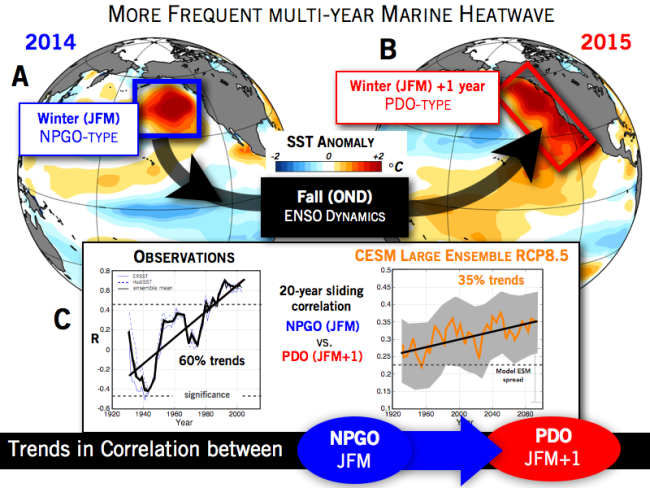Increasing coupling of Pacific dynamics leads to prolonged marine heatwaves
During the prolonged marine heatwave of 2014–15 in the Northeast Pacific (e.g., the Blob), warm temperature anomalies in excess of +2 degrees Celsius persisted over the North Pacific through an evolution of spatial patterns from the open ocean in 2014 to the coast in 2015 (A to B in the figure). The boreal winter pattern in January-February-March (JFM) of 2014 resembled the typical expression of the North Pacific Gyre Oscillation (NPGO), while the winter pattern in the following year resembled the Pacific Decadal Oscillation (PDO). This progression of patterns is linked to tropical-extratropical teleconnections. Specifically, the atmospheric forcing of the NPGO mode in winter/spring is recognized to excite ocean-atmosphere feedbacks that act as precursors of the El Niño Southern Oscillation (ENSO). In turn, ENSO dynamics during October–December in the tropics energize atmospheric teleconnections that drive a PDO response in the North Pacific the following winter.

In a recent study, Joh and Di Lorenzo find that this coupling (from NPGO to ENSO to PDO) has been increasing in observational records between 1950–2017, leading to more frequent occurrences of multi-year warm events like the marine heatwave of 2014–15. To test the significance of this trend, the authors evaluate the strength of the coupling dynamics in the large ensemble of the Community Earth System Model (CESM-LENS) from 1900–2100 under the RCP8.5 emission scenario. Specifically, they compute a 20-year sliding correlation between NPGO and PDO as a measure of the winter-to-winter coupling. They find that all ensemble members exhibit this coupling with most of them exhibiting a statistically significant trend under warming conditions.
While the mechanisms underlying increased NPGO/PDO coupling under climate change need further investigation, other recently published work suggests that the mean warming of the Pacific basin may increase the ocean-atmosphere thermodynamics feedbacks that act to amplify an important ENSO precursor, known as the Pacific Meridional Mode. This intensification could explain the strengthening of tropical-extratropical coupling, which not only leads to prolonged year-to-year ocean temperature extremes but also energizes the Pacific decadal variability.
Increasing Coupling Between NPGO and PDO Leads to Prolonged Marine Heatwaves in the Northeast Pacific (Geophysical Research Letters)
Georgia Institute of Technology
Topics
- Pacific Ocean
- Weather
- Ocean Heat
- Air-Sea
- ENSO
- Extreme Events
